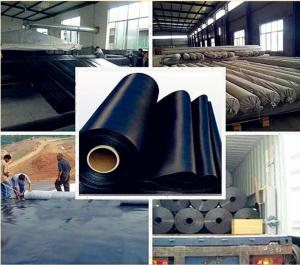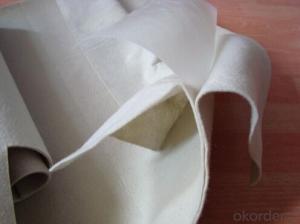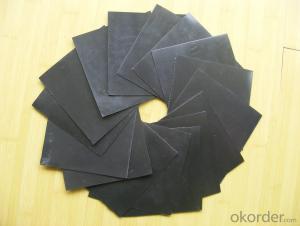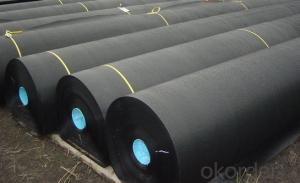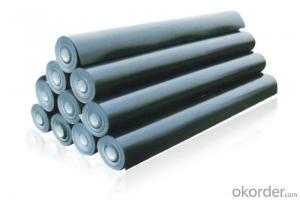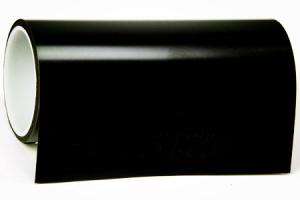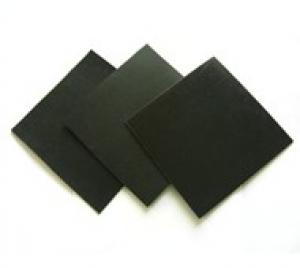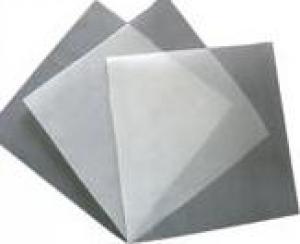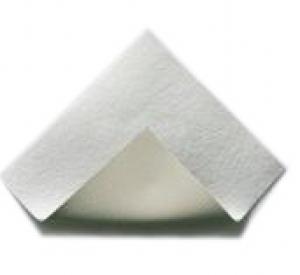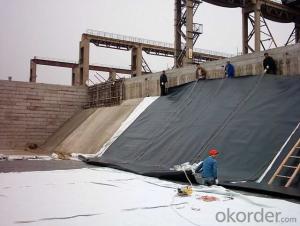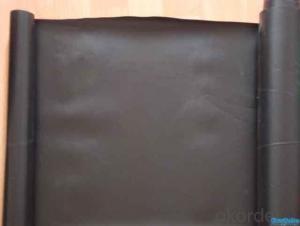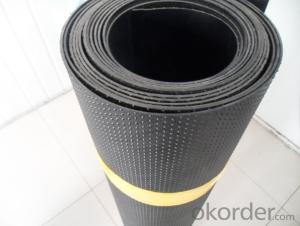Waterproof HDPE Geomembrane for Landfill to Prevent the Waste Water
- Loading Port:
- Qingdao
- Payment Terms:
- TT OR LC
- Min Order Qty:
- 10000 m²
- Supply Capability:
- 500000 m²/month
OKorder Service Pledge
OKorder Financial Service
You Might Also Like
Structure of Waterproof Hdpe Geomembrane for Landfill:
Geomembrane is a kind of waterproof material with basic raw material of high molecular polymer. It is mainly divided into LDPE geomembrane, HDPE geomembrane, and all kinds of composite geomembrane.
Main Features of Waterproof Hdpe Geomembrane for Landfill:
Complete variety of specifications of width and thickness. Thickness: 0.2-2.0mm.
Excellent environmental stress resistant cracking performance.
Excellent performance of chemical erosion resistance.
Big scope of application temperature and long service life .
Low Permeability :HDPE lining systems are secure because leachate does not penetrate them Methane gas will not escape from the HDPE cover system .and rainwater will not infiltrate.
Chemical Resistance:HDPE ,resistant to a wide range of chemicals ,is not threatened by typical solid or hazardous waste leachates.It is also suitable for sludge and secondary containment around chemical storage facilities
Ultraviolet Resistance:HDPE's resistance to UV exposure is further enhanced by the addition of carbon black .Additionally ,with the absence of plasticizers ,volatilization is not a problem .
Waterproof Hdpe Geomembrane for Landfill Images
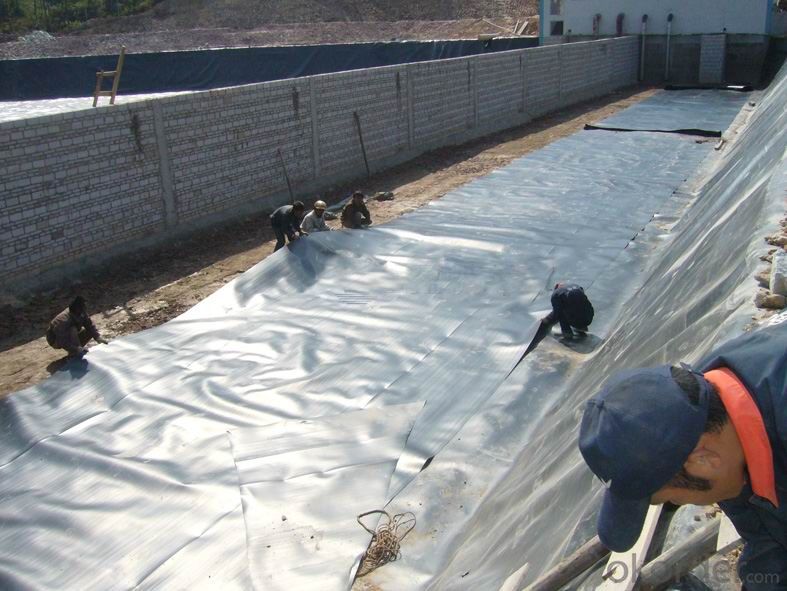

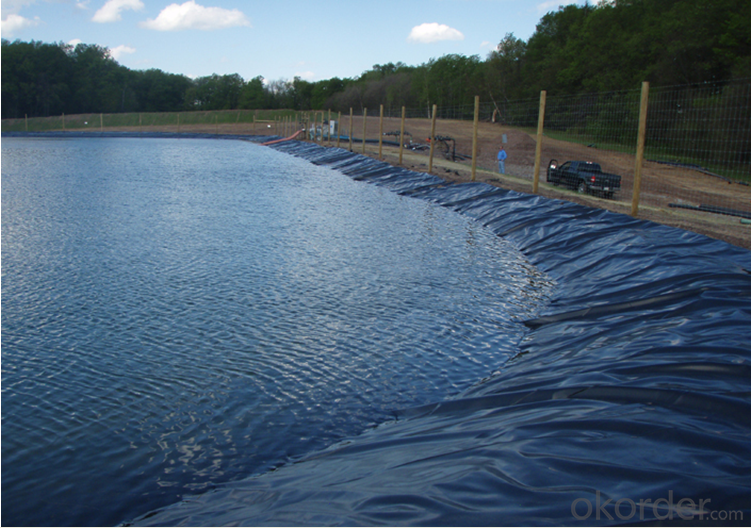
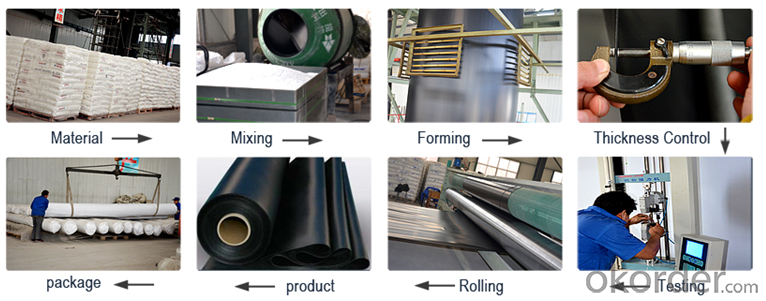
Waterproof Hdpe Geomembrane for Landfill Specification :
Thickness | Width | Length | Remark |
0.5mm | 5.8m ( Standard ) | 50m - 400m | The standard width is based on the max loading quantity according to the container size . It’s will be loading more quantity to save Freight cost .
For other types also could be produce as request , the exact package will send to you driectly . |
7.0m | 50m - 400m | ||
7.5m | 50m - 400m | ||
8.0m | 50m - 400m | ||
1.0mm | 5.8m ( Standard ) | 50m / 100m / 150m | |
7.0m | 50m / 100m / 150m | ||
7.5m | 50m / 100m / 150m | ||
8.0m | 50m / 100m / 150m | ||
1.5mm | 5.8m ( Standard ) | 50m / 100m / 140m | |
7.0m | 50m / 100m/ 140m | ||
7.5m | 50m / 100m/ 140m | ||
8.0m | 50m / 100m/ 140m | ||
2.0mm | 5.8m ( Standard ) | 50m / 100m | |
7.0m | 50m / 100m | ||
7.5n | 50m / 100m | ||
8.0m | 50m / 100m |
FAQ:
1. How about the delivery time?
Two weeks upon receipt of down payment.
2. What kind of payments do we accepted?
T/T, L/C, WesternUnion, MoneyGram.
3. What's are the MOQ?
Normally the MOQ is 5000 SQM in theory.
And we can provide you free samples for quality inspection.
4. Do you charge for the samples?
Accordeing to our company policy, the samples are freee, we only charge the freight fee. And we will return the freight fee in your second order.
5. Can you produce the product according to customers' requirements?
Sure, we are professional manufacturer, OEM and ODM are both welcome
- Q:Does thermal insulation glass need to stick membrane ?
- Yes, automotive films can also prevent explosion. Explosion-proof insulation film is made by electroplating metal on basilemma while general solar?film is made by painting on basilemma, and other ordinary explosion-proof membrane is film coated with aluminite powder, so they are different in reflective materials.
- Q:Principle of energy saving insulation film?
- Energy-saving insulation film maintains a constant indoor temperature by preventing the indoor and outdoor thermal convection. in summer when the outdoor temperature is higher than the indoor, energy-saving insulation film keeps the heat outside, keeping cooling inside; in winter, when outdoor temperature is lower than indoor temperature, saving insulation film prevent cold outdoor from entering indoor, and retain heat generated inside. the indoor temperature is not affected by the outdoor temperature. Energy-saving insulation film solar control performance is equivalent to 30 cm brick wall compared to a layer of insualting film, blocking up to 50% -90% of heat that enters into the house through the glass windows. Experiments show that when the outdoor temperature is 38-39 degrees Celsius, the application of energy-saving insulation film HONMO room indoor temperature lower than ordinary glass room 3-5 degrees.
- Q:Can geomembranes be used in green roof systems?
- Yes, geomembranes can be used in green roof systems. They are commonly used as a barrier to prevent water leakage and root penetration, helping to protect the roof structure and extend its lifespan. Additionally, geomembranes can aid in water retention and drainage management, contributing to the overall sustainability and functionality of green roof systems.
- Q:What is the role of geomembranes in groundwater protection?
- The role of geomembranes in groundwater protection is to act as a barrier or lining system to prevent the contamination of groundwater by hazardous substances. By providing a impermeable layer, geomembranes prevent the transmission of pollutants from waste storage facilities, landfills, or other potentially harmful sources into the underlying groundwater. This helps to safeguard the quality and availability of groundwater resources, ensuring their sustainability and protecting public health and the environment.
- Q:What are the advantages and disadvantages of ceramic and metal film membrane?
- (1) metal film in the 1990s is developed by the United States. it is mainly a porous and stainless steel substrate, TiO2 ceramic coating material is a new type of metal - ceramic composite inorganic membrane. (2) the advantages of a metal film is good ductility, toughness and strength, as well as adaptability to environment and material. It is one of the best film material after a ceramic membrane is developed. Ceramic membrane material is acid and akali resistance, anti chemical solvents, high temperatures resistant, especially with high mechanical strength, long service life. It has obvious advantages in harsh environments. The disadvantage is that the application of ceramic membrane is not wide enough, although it is nanoscale separation precision. ceramic membrane has a small market, but there is no ceramic membrane that can not filter. .
- Q:What are the considerations for geomembrane selection in desalination plants?
- When selecting a geomembrane for desalination plants, several factors need to be considered. These include the chemical compatibility of the membrane with the desalination process, its resistance to UV radiation and weathering, its permeability and hydraulic conductivity, its durability and resistance to punctures and tears, its ability to withstand high temperatures and pressures, and its overall cost-effectiveness. Additionally, the geomembrane should comply with any applicable regulatory requirements and standards to ensure its suitability for use in desalination plants.
- Q:Electrothermal?film and electric?hot?plate, which one is better?
- Electrothermal?film is recommended, the external transfer form of heat energy produced by it is thermal infrared radiation and convection, the conversion rate between electric energy and heat energy is more than 98%, which can immediately rise the temperature and ensure the stability of the indoor temperature, play the role of comfort, energy-saving and durability, safety. It is a worthy option.
- Q:What are the advantages of using geomembranes in hazardous waste containment?
- There are several advantages of using geomembranes in hazardous waste containment. Firstly, geomembranes are impermeable, meaning they prevent the migration of hazardous materials into the surrounding environment, reducing the risk of contamination. Secondly, they are highly durable and resistant to degradation, ensuring long-term protection for the waste and minimizing the need for maintenance or replacement. Additionally, geomembranes are flexible and can conform to the shape of the containment area, allowing for more efficient and cost-effective construction. Lastly, these liners are compatible with various waste types, making them versatile for different hazardous waste containment applications.
- Q:What are the benefits of using geomembranes in recreational water bodies?
- Using geomembranes in recreational water bodies can offer several benefits. Firstly, geomembranes act as a barrier, preventing the seepage of water into the ground and maintaining the desired water level. This helps in creating and maintaining artificial lakes, ponds, or swimming pools. Secondly, geomembranes are impermeable to gases, preventing the escape of harmful gases from the water body, ensuring a safe and healthy environment for recreational activities. Additionally, geomembranes provide protection against the infiltration of pollutants, preventing contamination of the water and maintaining its quality. Overall, the use of geomembranes in recreational water bodies enhances safety, water conservation, and environmental protection.
- Q:What is the best construction method for building a fishpond with geomembrane?
- The bottom and wall of the pond should be flat. Then the geomembrane is laid with 6 to 10 centimeters of it left on both sides. A layer of soil or fine sand of 8 to 10 centimeter thick with on sundries in it should be laid on the geomembrane as a protective layer to avoid damaging the geomembrane. If the fish pond wall is vertical, bricks can be laid and cement is plastered on the bottom and walls. If fish ponds is slanted, bricks do not need to be laid. Cement can be , directly plastered on the welded geomembrane.
1. Manufacturer Overview |
|
|---|---|
| Location | |
| Year Established | |
| Annual Output Value | |
| Main Markets | |
| Company Certifications | |
2. Manufacturer Certificates |
|
|---|---|
| a) Certification Name | |
| Range | |
| Reference | |
| Validity Period | |
3. Manufacturer Capability |
|
|---|---|
| a)Trade Capacity | |
| Nearest Port | |
| Export Percentage | |
| No.of Employees in Trade Department | |
| Language Spoken: | |
| b)Factory Information | |
| Factory Size: | |
| No. of Production Lines | |
| Contract Manufacturing | |
| Product Price Range | |
Send your message to us
Waterproof HDPE Geomembrane for Landfill to Prevent the Waste Water
- Loading Port:
- Qingdao
- Payment Terms:
- TT OR LC
- Min Order Qty:
- 10000 m²
- Supply Capability:
- 500000 m²/month
OKorder Service Pledge
OKorder Financial Service
Similar products
New products
Hot products
Hot Searches
Related keywords








